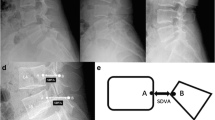Abstract
Introduction
As the ligamentum flavum (LF) covers most of the posterolateral part of the lumbar spinal canal, its thickening can be attributed to the development of lumbar canal encroachment. Nevertheless, there have been few reports describing the natural history of the LF.
Method
To investigate the natural history and to subsequently clarify the pathogenesis of LF thickening, we conducted a transverse radiological study of the LF at the lumbar spine using magnetic resonance images. Patients: One hundred and sixty-two patients complaining of low back pain and/or leg pain were evaluated (n = 162; mean age 52.1 years). The thickness of LF was measured at L2–3, L3–4, L4–5 and L5–S levels (n = 648). The relationships among thickness, age, and spinal level were examined.
Patients
One hundred and sixty-two patients complaining of low back pain and/or leg pain were evaluated (n = 162; mean age 52.1 years). The thickness of LF was measured at L2–3, L3–4, L4–5 and L5–S levels (n = 648). The relationships among thickness, age, and spinal level were examined.
Results
The following results were obtained. (1) LF thickness increased with age; however, the increments at L4–5 and L3–4 were larger than one at L2–3 and L5–S1. (2) At L4–5, LF was over 3.0 mm thick in patients in the 20–29 age bracket, and in many of them it was more than 3.5 mm thick. (3) All patients with a thickened LF at L2–3 (>3.0 mm) had very thick LFs at all spinal levels. (4) In elderly patients, there was no correlation between the thickness of LF and the decrease of the disc height. In this study, we concluded that thickening of LF at L4–5 had already started in patients in the 30–39 age bracket and that thickening of the LF was not the buckling of the LF into the spinal canal with disc degeneration. The thickness of LF at L2–3 may serve as an indicator of lumbar spinal canal stenosis at multiple levels.




Similar content being viewed by others
References
Beamer YB, Garner JT, Shelden CH (1973) Hypertrophied ligamentum flavum. Arch Surg 106:289–292
Elsberg CA (1931) Experiences in spinal surgery. Surg Gynecol Obset 16:117–135
Park JB, Chang H, Lee JK (2001) Quantitative analysis of transforming growth factor-beta 1 in ligamentum flavum of lumbar spinal stenosis and disc herniation. Spine 26:E492–E495
Towne EB, Reichert FL (1931) Compression of the lumbosacral roots of the spinal cord by thickened ligamentum flava. Ann Surg 94:327–336
Ullrich CG, Binet EF, Sanecki MG, Kieffer SA (1980) Quantitative assessment of the spinal canal by computed tomography. Radiology 134:137–143
Sairyo K, Biyani A, Goel V, Leaman D, Booth R Jr, Thomas J, Gehling D, Vishnubhotla L, Long R, Ebraheim N (2005) Pathomechanism of ligamentum flavum hypertrophy: a multidisciplinary investigation based on clinical, biomechanical, histologic, and biologic assessments. Spine 23:2649–2656
Ehni G (1965) Spondylotic cauda equina radiculopathy. Tex Med 61:746–752
Teng P, Papatheodorou C (1963) Myelographic findings in spondylosis of the lumbar spine. Br J Radiol 36:122–128
Yamada H, Ohya M, Okada T, Shiozawa Z (1972) Intermittent cauda equina compression due to narrow spinal canal. J Neurosurg 37:83–88
Pfirrmann CW, Metzdorf A, Zanetti M, Hodler J, Boos N (2001) Magnestic resonance classification of lumbar intervertebral disc degeneration. Spine 26:1873–1878
Fukuyama S, Nakamura T, Ikeda T, Takagi K (1995) The effect of mechanical stress on hypertrophy of the lumbar ligamentum flavum. J Spinal Disord 8:126–130
Nachemson AL, Evans JH (1968) Some mechanical properties of the third human lumbar interlaminar ligament (ligamentum flavum). J Biomech 1:211–220
Postacchini F, Gumina S, Cinotti G, Perugia D, DeMartino C (1994) Ligamenta flava in lumbar disc herniation and spinal stenosis: light and electron microscopic morphology. Spine 19:917–922
Schräder P, Grob D, Rahn BA, Cordey J, Dvorak J (1999) Histology of the ligamentum flavum in patients with degenerative lumbar spinal stenosis. Eur Spine J 8:323–328
Park JB, Lee JK, Park SJ, Riew KD (2005) Hypertrophy of ligamentum flavum in lumbar spinal stenosis associated with increased proteinase inhibitor concentration. J Bone Joint Surg Am 87:2750–2757
Okuda T, Baba I, Fujimoto Y, Tanaka N, Sumida T, Manabe H, Hayashi Y, Ochi M (2004) The pathology of ligamentum flavum in degenerative lumbar disease. Spine 29:1689–1697
Author information
Authors and Affiliations
Corresponding author
Rights and permissions
About this article
Cite this article
Sakamaki, T., Sairyo, K., Sakai, T. et al. Measurements of ligamentum flavum thickening at lumbar spine using MRI. Arch Orthop Trauma Surg 129, 1415–1419 (2009). https://doi.org/10.1007/s00402-009-0849-1
Received:
Published:
Issue Date:
DOI: https://doi.org/10.1007/s00402-009-0849-1




